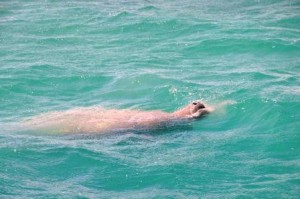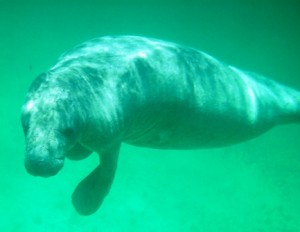Every year the West Indian Manatees make their way out to the reef at the North Point of Caye Caulker Marine Reserve. The manatees relax and enjoy the cooler waters of the reef. They come here to mate and they come to have the algae cleaned from their bodies from the reef fish. We are very luckly to have seen them so often this year. At Tsunami Adventures we offer small groups, which gives you a better opportunity to see the manatees. We do not harass the manatees.

Manatee taking a breath
Here is some information about the Manatees.
Although their bulbous, whiskery face makes this hard to believe today, manatees are probably the source of legends about mermaids. Their humanlike eyes must have captivated the early European sailors who caught fleeting glimpses of them swimming in the warm waters of the West Indies.
In the 17th century, mermaids were depicted with their male companions, mermen. Although the legends of these half-fish, half-human creatures have lived on for hundreds of years and are still popular today, it is uncertain whether the manatees that inspired the legends will live on much longer.
Only a concerted effort to protect them in their marine habitat will save manatees from extinction.

Manatee at North Point Caye Caulker
Manatees inhabit warm waters of the Western Atlantic from Florida to Brazil where they live in coastal waters, freshwater inlets, and river mouths.
Although their range is quite large, manatees today exist only in a few small, isolated populations. They once were widespread in rivers and along coasts in their range, but they were hunted extensively in the 18th and 19th centuries. Coastal development has further reduced their populations. Today, there are less than 2,000 manatees remaining in the United States.
The population of manatees in Belize has varied over the past decade, but is now estimated at 300-700 individuals. Despite this seemingly low number, Belize is thought to have the highest concentration of this subspecies in the world. However, the current population is significantly lower than a century ago and is continuing to decline. What is causing the West Indian manatee to hover near extinction?
Reports of declining manatee populations due to hunting date back to 1883. In spite of the Manatee Protection Ordinance of 1935 and the more recent protection under the Wildlife Protection Act, illegal hunting has persisted. Reports of manatee bones at butcher sites is evidence that manatees are still taken for local consumption, especially in Southern Belize, but currently the primary threat is the exportation of meat to neighboring countries such as Honduras and Guatemala. Another threat exists in boat collisions with manatees; propeller-scarred manatees are becoming an increasingly common site. Moreover, as boat traffic increases, manatees are left with fewer undisturbed creeks and channels for calving and resting areas, thus they are forced to seek out less suitable habitats to avoid such harassment. In the search for habitat, manatees often find themselves susceptible to entrapment and death due to gill netting in rivers and across river mouths. Finally, it should come as no surprise that industrial and agricultural pollution, as well as effluent from domestic sewage, adversely affects the health of manatees and potentially destroys the vegetation on which they feed. Increased coastal development has made this a significant threat.
It seems that with such a high number of threats, the manatee has an uphill battle for survival. Fortunately, over the past decade, the people of Belize have made great strides in preventing further loss of this species. Public awareness campaigns and educational workshops have helped to increase enforcement of regulations. Still, more enforcement is needed to protect this species, whose fate hangs in the balance.
The manatee is a large, bulky aquatic mammal with flippered forelimbs and a spatula-shaped tail. Manatees can grow to 12 feet in length and weigh up to 3500 pounds. They may live to be 50 years old.
The manatee diet consists entirely of vegetation, consuming at a rate of 100 pounds a day. They eat by using their divided upper lip, which is very flexible, to grasp and take in aquatic plants. Like other air-breathing marine mammals (dolphins, whales, and seals), manatees must periodically surface for air.
Females reach sexual maturity between five and nine years of age, but they do not produce many offspring; more animals are killed each year than are born. Mothers are strongly bonded to their calves, but other social ties among manatees are very loose. They are extremely gentle and have been described as incapable of aggression.
Manatees are one of four living species in the Order Sirenia, which also includes the West African manatee, the Amazonian manatee, and the dugong. Another sirenian, the Steller’s sea cow, became extinct in the 1700s. The sirenians evolved from an ancestor they share with the elephant, their closest living land relative.
Tourism
Manatees spend hours grazing underwater everyday, and they can be very exciting to watch in their natural habitat. Manatee-watching tourism gives local people a financial incentive to preserve the species, since tourists spend their dollars at local businesses. Tourists may be inspired to do something to help these beautiful and mysterious creatures.
Here in Belize, manatee-watching tourism has been a very successful conservation action. Not long ago, local people hunted manatees with rifles, while today manatees are a big attraction for tourist dollars.
More scientific research is needed to understand manatees and their needs. One current study is tracking manatees by satellite to learn more about where they go and what they do. We need to know more about their calving and feeding behaviors.
www.swallowcayemanatees.org








